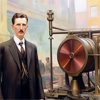The World’s Workshop: Early Inventive Achievements Of The 20th Century
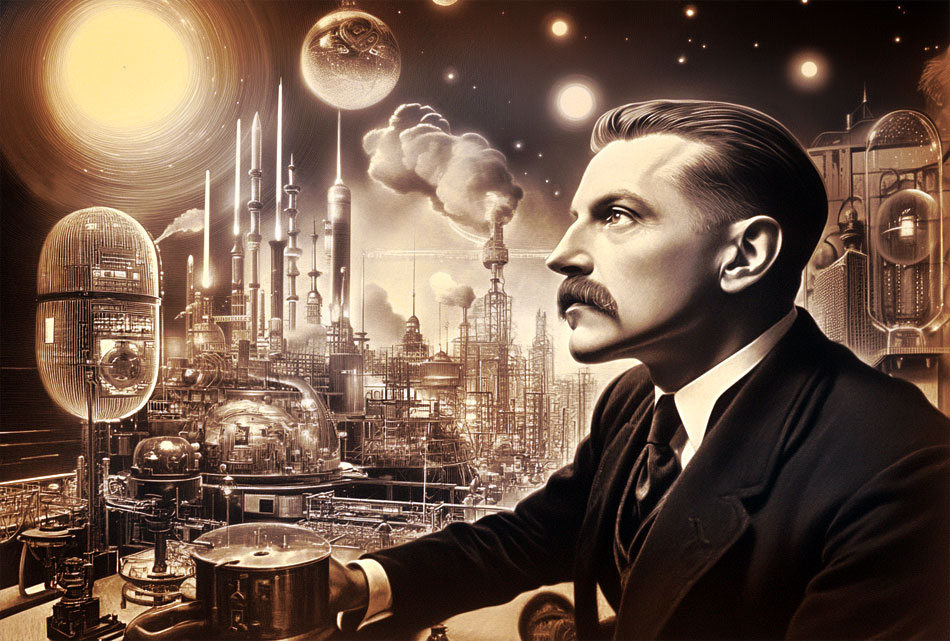 by W.J. Jackman, Trumbull White, and Ferdinand E. Cary (1911)
by W.J. Jackman, Trumbull White, and Ferdinand E. Cary (1911)
Wonderful indeed is this world’s workshop, for its doors are open wide and all that is within can be seen and understood – whether it be in an airship above the clouds, upon or under the sea, in the city, town or country; all that has been wrought by man for the progress and advancement of the world is arrayed under the broad head “The World’s Workshop”.
Introduction
This is the Marvelous Age, the age of triumphant Progress. Follow the records of mankind down through all the centuries scrutinize the achievements of the race, and more and more conspicuous becomes the fact that in no other period of the world have such wonderful advances in material and industrial progress been made. Within the last decade we have seen hundreds of inventions and discoveries, any one of which would be sufficient to illuminate a whole century of the Middle Ages.
The history of man is shown in his works. From the days of the cave and cliff dwellers, the days of stone hatchets and bronze tools, the days of primitive life and primitive emotions, we have come to a day when the race is housed and fed and clothed and enlightened as never before, with improvement still a constant tendency. A palace in medieval times did not contain the genuine comforts of a mechanic’s home of today. A Monarch two centuries ago could not have half the real conveniences or the luxuries at his command that are easily in the possession of any modern householder. So, it is of high interest to examine the workshops of today, to observe the sources and the methods of the amazing activities that are enthroned in our high places.
Inventions have had to face oppositions throughout the whole history of the world, even until today. The self-binding reaper was one of the triumphs of modern invention in the mechanical field, but it was riotously assailed as revolutionary and disastrous to industry by mobs of agricultural laborers who saw their occupation vanishing. Yet the broad prairies of the Great West have been brought under cultivation, and homes and employment have been created for millions, by the improvement in agricultural machinery. The typesetting machine was opposed because one would do the work of several hand compositors, and many men would be discharged, but newspapers have multiplied and enlarged by its introduction, and the whole craft has ultimately benefited thereby.
In the volume presented herewith [full download below], it has been planned to put in the possession of the reader such an array of facts and information of genuinely educational character as would enable him to observe clearly the greatness of this industrial age and its tendencies. The methods and results of the great industrial and commercial undertakings of the world; the modern world of invention, discovery and scientific enlightenment; the more noteworthy works of nature which bear upon man and his achievements, and a mass of matter concerning the things we need to know in every channel of human activity and interest – these are the general contents of the volume in hand.
The work is not a history, though it contains much of historical enlightenment. It is not an encyclopedia, though it contains an encyclopedic volume of information. Instead of these it is a book that tells what is being done in the World’s Workshops today, for reading, for reference, for education and for study. In it a mass of material has been so arranged by a natural classification as to be readily at hand for convenient use for any purpose. Under the general heading of The World’s Workshop are included accounts of the great commercial, manufacturing, industrial and financial undertakings which have risen so rapidly of late years. Their interesting phases are explained and pictured and the great cities of the world contribute to these pages.
The triumphs of modern science, invention and discovery are shown in startling array, an evidence of the capacity of the human mind to encompass almost any achievement that genius suggests.
The works of nature, which outvie all the deeds of man, are an exhaustless field of inquiry and interest. Here such are selected as are commanding in their importance and of immediate interest at the present day for some special reason that brings them into prominence.
With the assurance that this work will command and justify attention by its plan and execution, placing readily at hand as it does the information for which everyone is seeking in regard to the world, its conditions and its activities today, it is presented herewith to the reader.
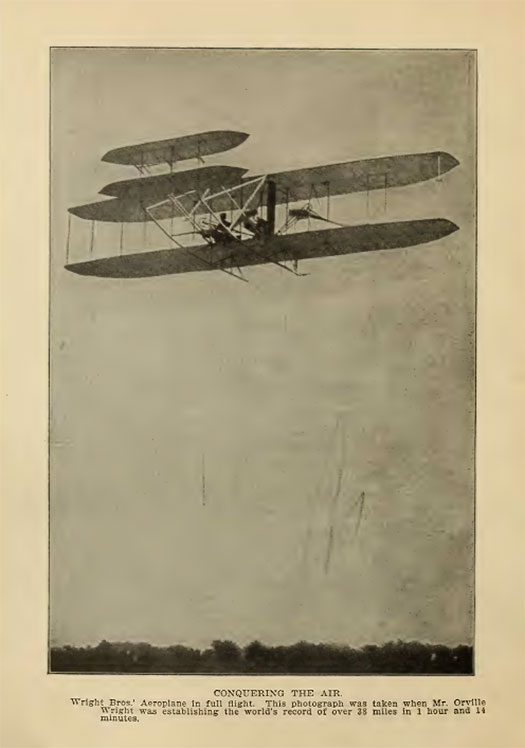 It is only a little over seven years since the first practical motor-driven flying machine was put in operation. In that comparatively short time remarkable advance has been made, not only in methods of construction, but as regards to systematic operation as well, and what was at first regarded as simply an interesting scientific experiment of no particular commercial value, has been developed to a stage of assured usefulness.
It is only a little over seven years since the first practical motor-driven flying machine was put in operation. In that comparatively short time remarkable advance has been made, not only in methods of construction, but as regards to systematic operation as well, and what was at first regarded as simply an interesting scientific experiment of no particular commercial value, has been developed to a stage of assured usefulness.
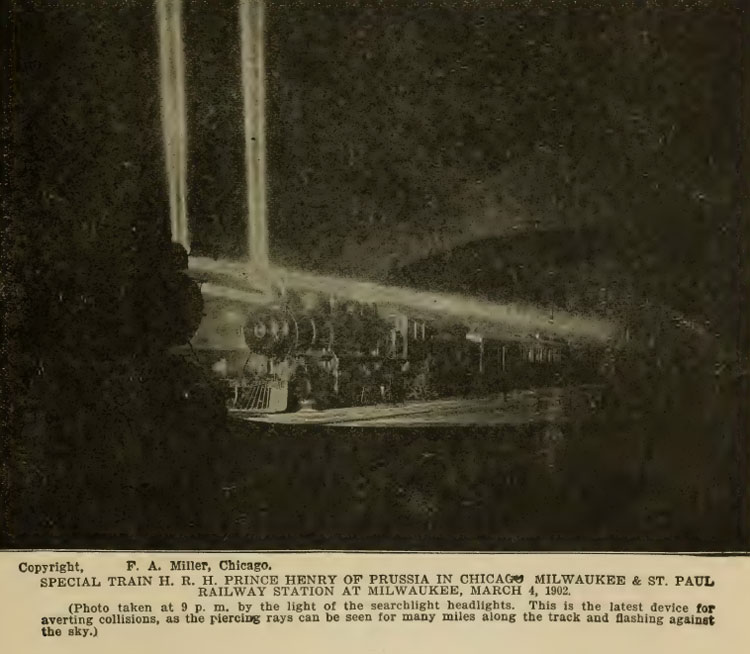 The most able financial organizations, the most skillful executives, and the most ingenious inventors, are devoting their attention to the construction, operation and perfection of railway systems. Improvement in the modern railways over those of only a few years ago is conspicuous. Old roads are reconstructing their lines and new ones built with the utmost care to assure the permanency of their tracks, the economy of their administration and the comfort of their travelers. Heavy steel rails have supplanted the light ones of iron; rock ballast is used where earth formerly sufficed; steel bridges span streams and the old wooden culverts are burned at the roadside; curves are straightened, grades are reduced, tunnels penetrate the mountains where trains formerly surmounted the summit by slow climbing. All this contributes to the safety, ease and speed of the journey, but it likewise reduces the cost of maintenance and operation, so that the railway companies find direct as well as indirect profit from their increasing expenditures. The elevation of tracks through cities, thus eliminating grade crossings, and the perfection of various block signals and safety switch systems, help to give additional safety to traffic and make high speed possible.
The most able financial organizations, the most skillful executives, and the most ingenious inventors, are devoting their attention to the construction, operation and perfection of railway systems. Improvement in the modern railways over those of only a few years ago is conspicuous. Old roads are reconstructing their lines and new ones built with the utmost care to assure the permanency of their tracks, the economy of their administration and the comfort of their travelers. Heavy steel rails have supplanted the light ones of iron; rock ballast is used where earth formerly sufficed; steel bridges span streams and the old wooden culverts are burned at the roadside; curves are straightened, grades are reduced, tunnels penetrate the mountains where trains formerly surmounted the summit by slow climbing. All this contributes to the safety, ease and speed of the journey, but it likewise reduces the cost of maintenance and operation, so that the railway companies find direct as well as indirect profit from their increasing expenditures. The elevation of tracks through cities, thus eliminating grade crossings, and the perfection of various block signals and safety switch systems, help to give additional safety to traffic and make high speed possible.
The combined length of the railways of the United States amounts to nearly 200,000 miles, and of the whole world to approximately 500,000 miles. The increase is at the rate of about 10,000 miles a year the world over. If the actual cost of construction and equipment, the production of the materials out of which the lines are built, the employees engaged in railway, operation, and the interests which depend for their prosperity on the railway are considered, it may be safely said that the railway is the greatest industrial factor in the world today.
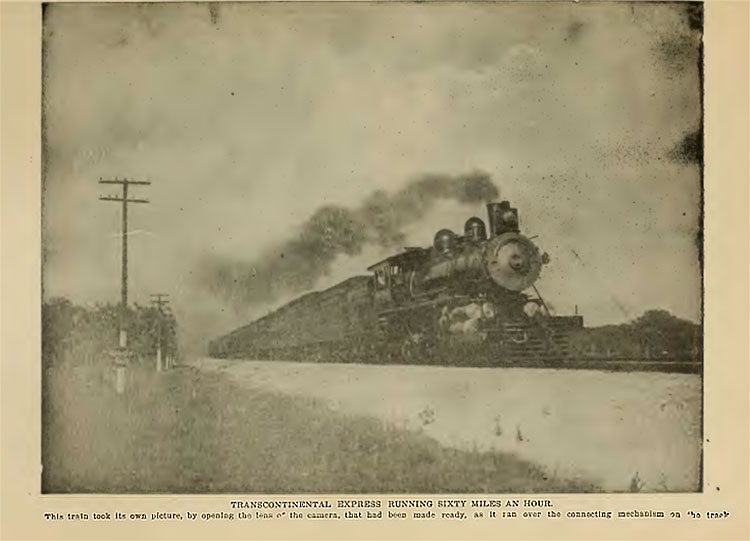 In Asia the whole political and military situation has been affected by the construction of the Trans-Siberian railway, built by the Russian Government. Extending all the way from the European provinces of the empire as it does, across the whole of Asia, to a terminus on the Pacific Ocean, it provides a speedy route by which armies may be shifted to any scene of threatened difficulty at the will of the Emperor.
In Asia the whole political and military situation has been affected by the construction of the Trans-Siberian railway, built by the Russian Government. Extending all the way from the European provinces of the empire as it does, across the whole of Asia, to a terminus on the Pacific Ocean, it provides a speedy route by which armies may be shifted to any scene of threatened difficulty at the will of the Emperor.
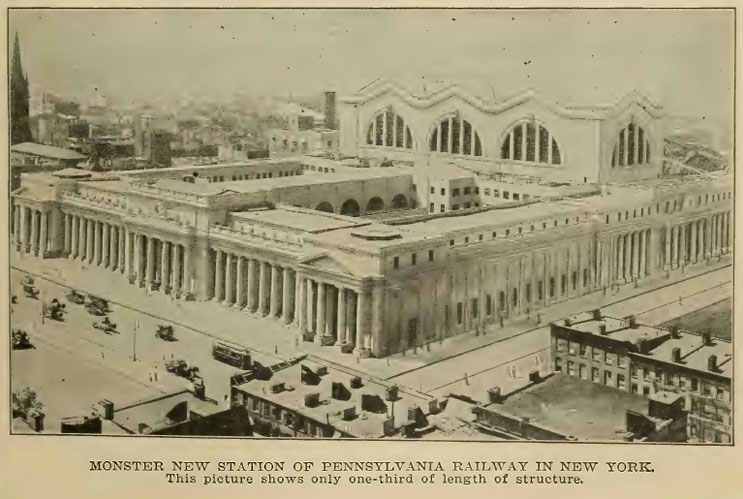 In 1906 the Pennsylvania railroad eastern terminus was at Jersey City. In that year the trains of this company landed 140,000,000 people in Jersey City, virtually all of whom were carried across the Hudson river by ferry boats to New York. In September, 1910, the company opened a mammoth station located in the central part of New York City, and began to move its trains through tunnels constructed under the Hudson river, Manhattan island, and the East river. By the use of this tunnel system passengers, instead of being ferried across the Hudson river, are landed in the New York station, while those bound for points on Long Island may continue on through the tunnel under the East river. The new station building is 740 feet long, 430 feet wide, and of an average height of 69 feet, the maximum being 153 feet.
In 1906 the Pennsylvania railroad eastern terminus was at Jersey City. In that year the trains of this company landed 140,000,000 people in Jersey City, virtually all of whom were carried across the Hudson river by ferry boats to New York. In September, 1910, the company opened a mammoth station located in the central part of New York City, and began to move its trains through tunnels constructed under the Hudson river, Manhattan island, and the East river. By the use of this tunnel system passengers, instead of being ferried across the Hudson river, are landed in the New York station, while those bound for points on Long Island may continue on through the tunnel under the East river. The new station building is 740 feet long, 430 feet wide, and of an average height of 69 feet, the maximum being 153 feet.
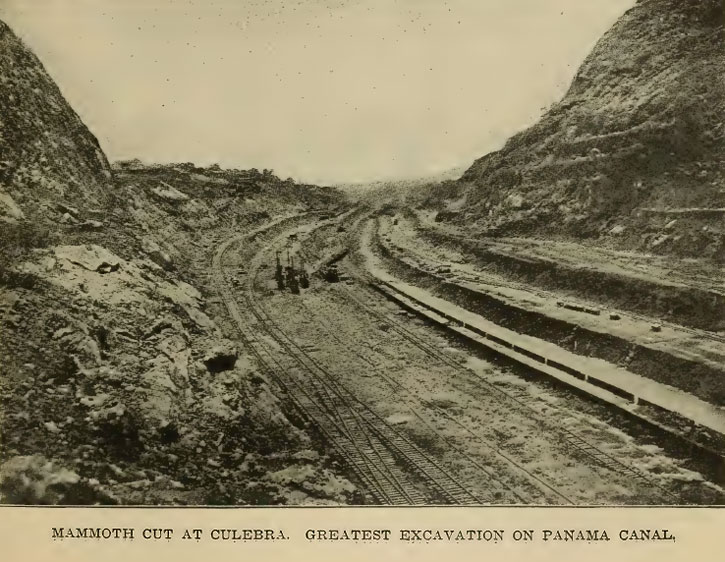 As a preliminary to the construction of the Panama canal, connecting the waters of the Atlantic and Pacific oceans, the United States government in 1902 bought for $40,000,000 the rights of the French company which held a franchise for the work, but which had virtually abandoned operations. In 1904 it acquired from the Panama republic control over a strip of country reaching from Colon on the Atlantic coast to Panama, on the Pacific, and averaging about 10 miles in width. This strip, which cost the United States $10,000,000, is known as the Canal Zone. Within its limits the Americans are in control, administering the laws and exercising undisputed police powers.
As a preliminary to the construction of the Panama canal, connecting the waters of the Atlantic and Pacific oceans, the United States government in 1902 bought for $40,000,000 the rights of the French company which held a franchise for the work, but which had virtually abandoned operations. In 1904 it acquired from the Panama republic control over a strip of country reaching from Colon on the Atlantic coast to Panama, on the Pacific, and averaging about 10 miles in width. This strip, which cost the United States $10,000,000, is known as the Canal Zone. Within its limits the Americans are in control, administering the laws and exercising undisputed police powers.
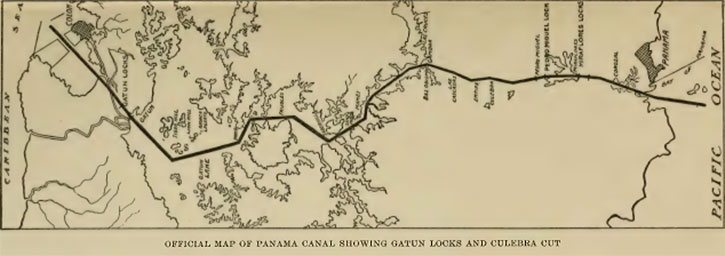 When completed the canal will be about 50 miles in length, counting the deep water entrances at each end. The actual length of the canal proper is 40 1/2 miles. In bottom width the canal varies, the minimum being 300 feet at the Culebra cut and the Pedro Miguel lock, and the maximum 1,000 feet from the south end of the Gatun locks to mile 23.50, a distance of a bout 16 miles. The minimum depth is 41 feet. The extreme width of 1,000 feet is occasioned by the utilization of the River Chagres and Gatun Lake as a part of the route.
When completed the canal will be about 50 miles in length, counting the deep water entrances at each end. The actual length of the canal proper is 40 1/2 miles. In bottom width the canal varies, the minimum being 300 feet at the Culebra cut and the Pedro Miguel lock, and the maximum 1,000 feet from the south end of the Gatun locks to mile 23.50, a distance of a bout 16 miles. The minimum depth is 41 feet. The extreme width of 1,000 feet is occasioned by the utilization of the River Chagres and Gatun Lake as a part of the route.
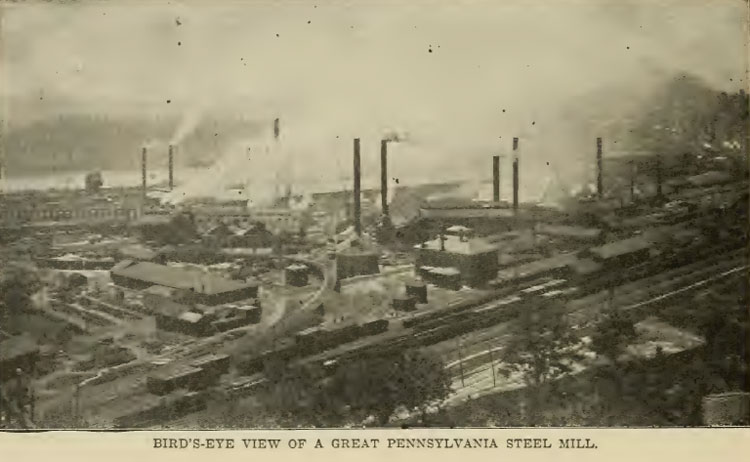 Steel is the material from which this industrial age builds its marvelous machinery, its great buildings, its railways and its steamships. Steel, it is, upon which our multi-millionaires have built their fortunes, fortunes which excel all wealth in the history of the world. The steel trust, it is, the formation of which has done more than any other single influence to draw the attention of the public at large to the enormous consolidations of capital for the dominance of the industrial world, not alone in America, but all over the globe. So it becomes of prime interest and importance to observe the progress of the industry and its products from the mine to the consumer.
Steel is the material from which this industrial age builds its marvelous machinery, its great buildings, its railways and its steamships. Steel, it is, upon which our multi-millionaires have built their fortunes, fortunes which excel all wealth in the history of the world. The steel trust, it is, the formation of which has done more than any other single influence to draw the attention of the public at large to the enormous consolidations of capital for the dominance of the industrial world, not alone in America, but all over the globe. So it becomes of prime interest and importance to observe the progress of the industry and its products from the mine to the consumer.
There is a wide distance between the primitive miner and molder of prehistoric times, with his rough furnace, his rude appliances, and the customers of his neighborhood, and the remarkable organization of mines, transportation facilities and manufacturing plants which now unite to form the great iron and steel interests. The United States Steel Corporation, as the trust is officially entitled, with its capital of $1,100,000,000, is by far the greatest organization in the world. And yet it does not include by any means all the branches of the industry in America and the foreign fields, in which other great organizations exist.
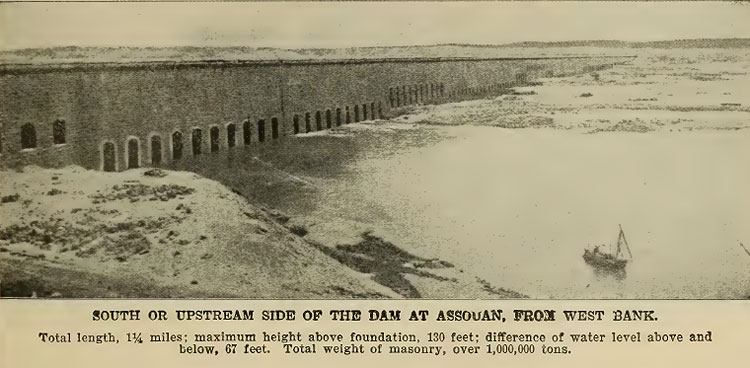 The monumental dam at Assouan, which is by far the greatest achievement of its kind in ancient or modern times, forms a reservoir in the Nile valley capable of storing 1,000,000,000 tons of water, practically creating a lake more than 140 miles long. The foundation stone was laid by the Duke of Connanght on February 12, 1899. At times fifteen thousand men have been employed, and work has gone on day and night. At other times, when the Nile was in flood, labor had to be suspended for several weeks.
The monumental dam at Assouan, which is by far the greatest achievement of its kind in ancient or modern times, forms a reservoir in the Nile valley capable of storing 1,000,000,000 tons of water, practically creating a lake more than 140 miles long. The foundation stone was laid by the Duke of Connanght on February 12, 1899. At times fifteen thousand men have been employed, and work has gone on day and night. At other times, when the Nile was in flood, labor had to be suspended for several weeks.
One gains a clearer idea of the magnitude of the task by recalling the first step taken; that was, to divert the channel and excavate in the rocky riverbed a trench one hundred feet wide and as many feet deep, in which to lay a concrete foundation for the massive piers.
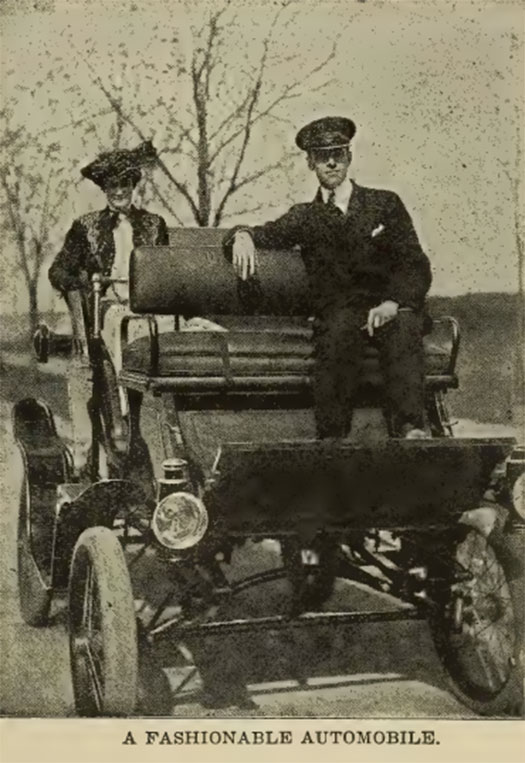 The age has arrived when the horse as a means of power for general traction is well on the wane. While it is not intended by this statement to convey the idea that the time will come when horses will no longer be used to draw vehicles, nevertheless the development in the past decade of the automobile, or automatic vehicle, has attained such success that it is no longer a mere experiment. Today, upon the streets of any of our cities may be seen horseless carriages, trucks, wagons and fire engines, while in the country the traction engine and the automatic plow are gradually coming into use.
The age has arrived when the horse as a means of power for general traction is well on the wane. While it is not intended by this statement to convey the idea that the time will come when horses will no longer be used to draw vehicles, nevertheless the development in the past decade of the automobile, or automatic vehicle, has attained such success that it is no longer a mere experiment. Today, upon the streets of any of our cities may be seen horseless carriages, trucks, wagons and fire engines, while in the country the traction engine and the automatic plow are gradually coming into use.
The principal motive powers for the motor vehicle today are electricity, gasoline and steam, although there are several chemical and other agents, such as compressed air, which are in occasional use. In general, however, it may be stated that the last named have been dropped.
 Great has been the progress in building in the last decade. Time was when a ten-story office building would have been deemed an affront to Providence. But with the invention of the modern elevator and the rapid advance of land values in great cities, architects and contractors began seriously to study out methods for accommodating great numbers of tenants in individual buildings. As long as buildings had to be constructed solely of brick and masonry there was a definite limit to their height, for, as the height grew so grew the weight of the walls and further altitude had to be sacrificed when it became impossible to fit the walls to carry the height without undue expenditure.
Great has been the progress in building in the last decade. Time was when a ten-story office building would have been deemed an affront to Providence. But with the invention of the modern elevator and the rapid advance of land values in great cities, architects and contractors began seriously to study out methods for accommodating great numbers of tenants in individual buildings. As long as buildings had to be constructed solely of brick and masonry there was a definite limit to their height, for, as the height grew so grew the weight of the walls and further altitude had to be sacrificed when it became impossible to fit the walls to carry the height without undue expenditure.
At the junction of Fifth avenue, Broadway and Twenty-third street, New York, stands a unique structure, probably the strongest ever erected. It is known as the “flatiron” building, and is the cumulative result of all that is known in the art of building. It is equipped with every convenience that human ingenuity could devise.
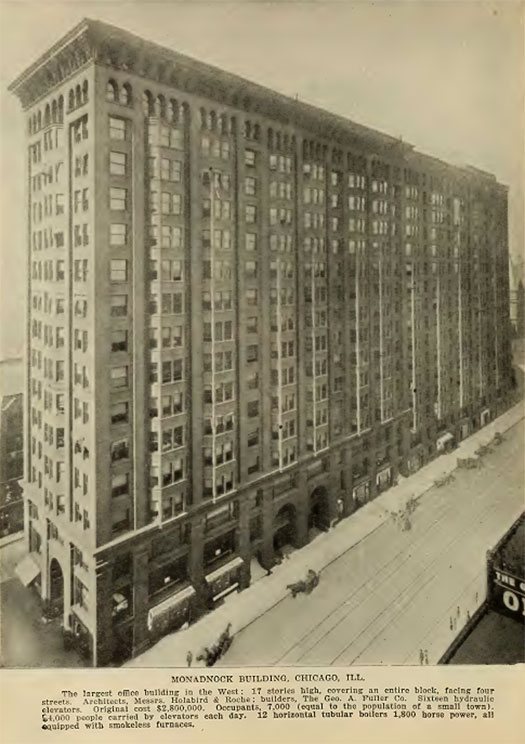
Suddenly there appeared an engineer who solved the problem by propounding the idea of building steel structures after the fashion of gigantic bridges set on end, and to hang the walls on — that is, to make the girders and beams support the floors and walls, instead of making the walls support everything. This was called Chicago construction, because it originated with a Chicago man. Building under this method each floor is absolutely independent so far as the walls and partitions are concerned, for the walls have nothing but their own weight to carry in the height of each story. It is no uncommon thing on “Chicago construction” buildings for the contractor to begin his exterior work on the third, fifth or ninth story, leaving the first to be enclosed after every other floor has been walled in and plastered. This method of building is diametrically opposed to the old-fashioned solid-masonry construction, which begins at the very bottom with the foundation and rises to the roof, with the piers, exterior walls and partition walls going up together. The contractor, building a skyscraper according to “Chicago construction,” shoots the steel framework up as rapidly as possible, so as to get the roof on to protect the interior from the weather. With the framework up, he puts in the hollow tile partitions or builds the walls to suit his convenience. This method of building set all traditions, rules and time-honored customs of architects and builders at naught, for it ignored massive foundations, heavy piers, the use of thick walls to carry weight, and solid partition walls running from the foundation to the roof.
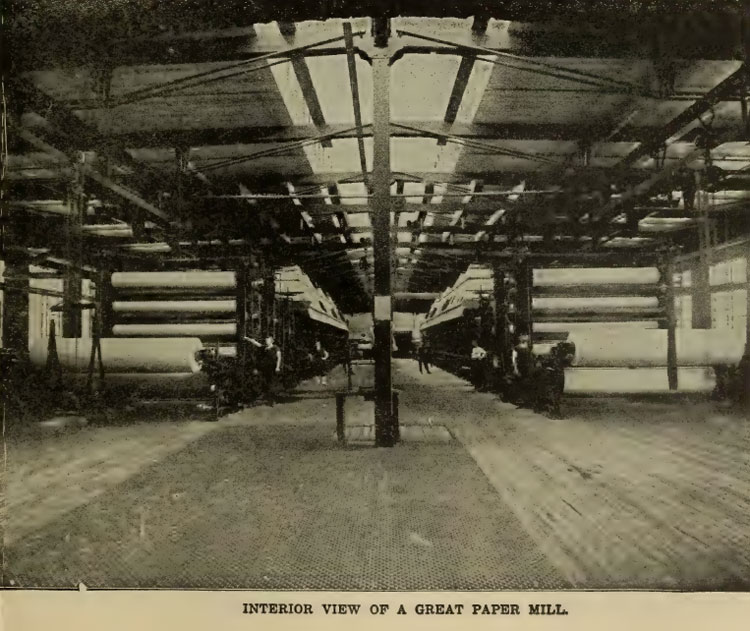 The great bulk of what is used in books, magazines and newspapers comes from wood pulp, the newest development in modern paper manufacture. The different fibers used in paper-making, whether of wood or rags, do not differ greatly after their mechanical and chemical treatment is finished. When the logs are cut in the forests, the bark is stripped from them and they are sent to the factory. Here they are sawed and split into small blocks, after which they are ground to a powder which becomes a pulp when diluted with water. This pulp, chemically treated to bleach it and to remove all resinous and foreign matters, then passes through processes similar to those by which paper is made from rags.
The great bulk of what is used in books, magazines and newspapers comes from wood pulp, the newest development in modern paper manufacture. The different fibers used in paper-making, whether of wood or rags, do not differ greatly after their mechanical and chemical treatment is finished. When the logs are cut in the forests, the bark is stripped from them and they are sent to the factory. Here they are sawed and split into small blocks, after which they are ground to a powder which becomes a pulp when diluted with water. This pulp, chemically treated to bleach it and to remove all resinous and foreign matters, then passes through processes similar to those by which paper is made from rags.
Paper fills an important place in many mechanical arts, and there are various novelty papers made which have important uses. Paper made with a quantity of asbestos fiber is used for fire-proofing purposes; tar paper is used for covering roofs and lining walls; photographs are made up on paper rendered sensitive by a chemical process; carbon paper, transparent paper, stencil paper, gunpowder paper, safety paper for bank checks, and other familiar forms are but developments of the ordinary paper products. Sand and emery papers are prepared by coating a sheet of paper with glue, and then sprinkling sand or emery dust upon the surface. Car wheels, lumber, buckets and tubs, and many articles of common use are made from paper pulp.
The United States leads in paper-making, producing about one-third of all that is used on the globe. The city of Holyoke, Massachusetts, is the greatest paper center in the world for expensive papers of linen. The cheaper grades of paper, from wood pulp, are made in great quantities in the mills of Maine, Canada and Wisconsin, convenient to the forests which provide the material.
![]() More subjects covered as follows from the Table Of Contents with over 500 photographic illustrations:
More subjects covered as follows from the Table Of Contents with over 500 photographic illustrations:
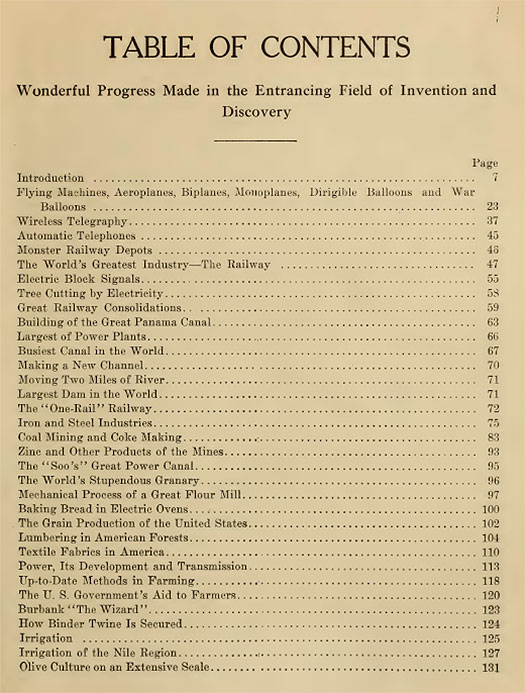
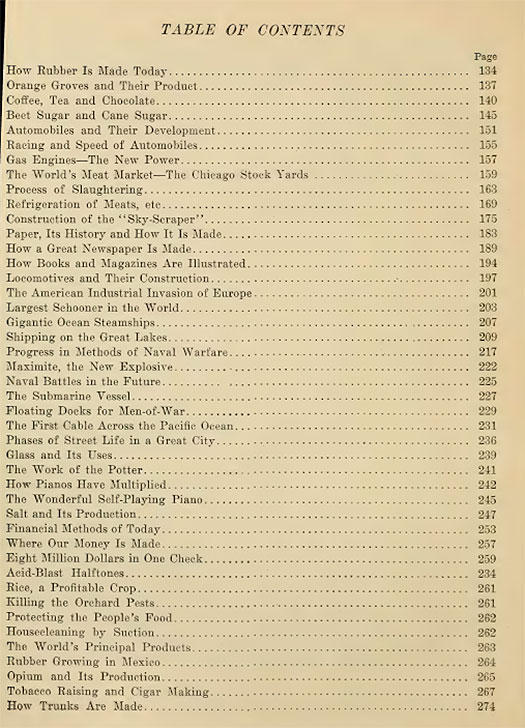
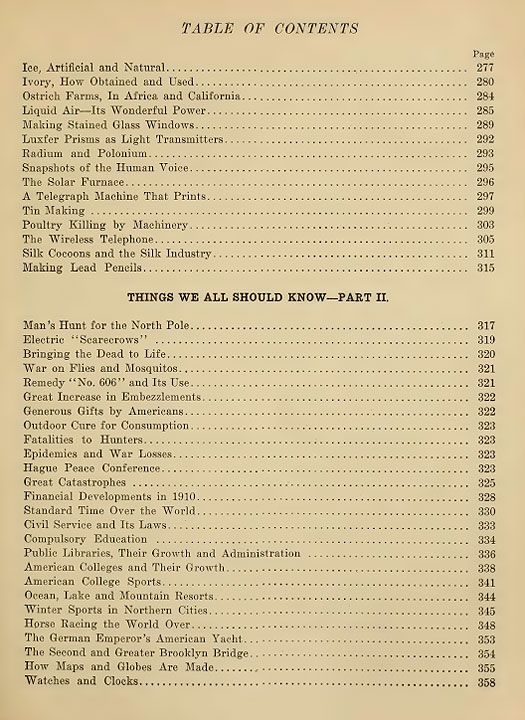
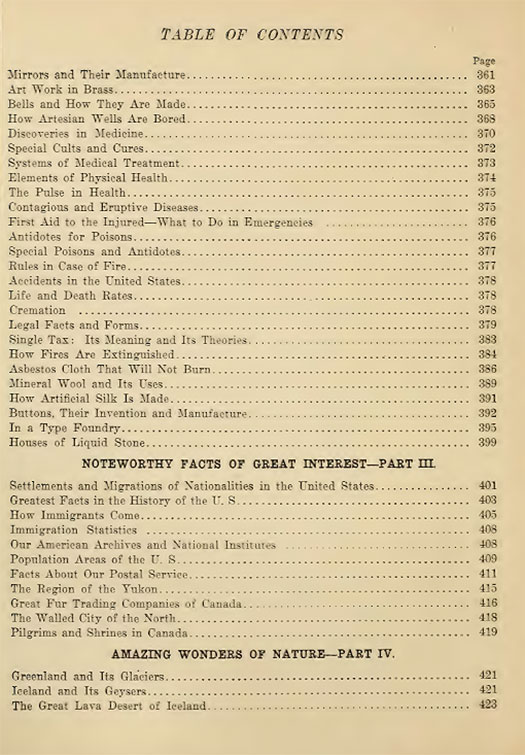
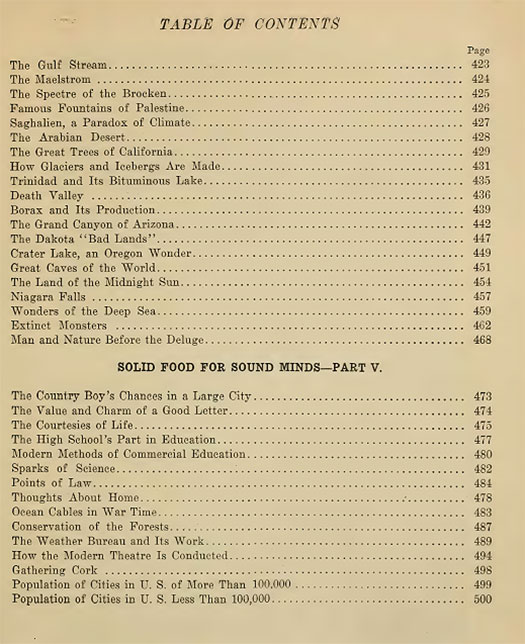
The World’s Workshop: Science, Invention, Discovery, Progress
– full book download here.
Posted in Other Topics, True History of Manwith comments disabled.





